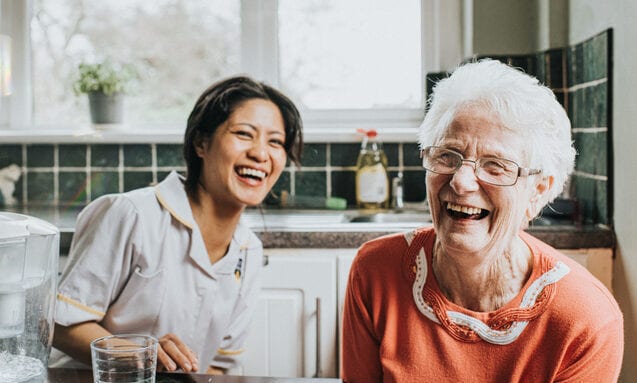In this article
Being the primary caregiver comes with its fair share of challenges — not least of which can be knowing when and how to fill other family members in on what’s happening with your loved one, and asking for help when necessary.
“Family members’ involvement helps shoulder the mental and emotional load of being the primary caregiver,” says Katie Durbin, a licensed clinical social worker and owner and clinician at Health Transitions Counseling in Lombard, Illinois. “It minimizes that overwhelming feeling that it all falls on them. There is a huge relief in knowing others are part of the experience, and you are not alone.”
Plus, keeping family and close friends updated gives them a chance to learn how and when they can help, says Durbin. And that help is key.
“The option to delegate needs also provides more opportunity for the caregiver to engage in self-care, which is crucial for their physical and mental health,” she says.
“The option to delegate needs also provides more opportunity for the caregiver to engage in self-care, which is crucial for their physical and mental health.”
— Katie Durbin, owner, Health Transitions Counseling
Here are some ideas for keeping family members in-the-know — and getting everyone on board.
Key takeaways
- Be specific when asking for help to avoid confusion with other family members.
- Assign roles based on family strengths to prevent caregiver burnout.
- Consider using caregiving apps to keep family updated and share the load.
Get specific on how to help
As Durbin says, having help can provide caregivers with some much-needed downtime. But knowing how to ask family and friends for that help can be tricky.
Alison Lynn, a licensed clinical social worker and the associate director of social work at Penn Memory Center in Philadelphia offers this advice: “When you’re asking for something, try to make it specific and measurable in some way.”
That’s because an open-ended statement (e.g. “I could use some help”) can lead to confusion, missed opportunities and disappointment, she says. Instead, take the person’s strengths and limitations into consideration and then come up with ideas for how they, specifically, can help, says Lynn.
“When you’re asking for something, try to make it specific and measurable in some way.”
— Alison Lynn, licensed clinical social worker
One example: If you want a family member to call more often, explain how their loved one may not initiate phone calls but enjoys hearing from them — and then suggest a regular call time every other Friday at noon, she says.
Assign roles
Identify your needs and who in the family is best equipped to handle them, Durbin says — and then, if possible, assign the role to that person. A family member who is financially-savvy can handle money management, while a research-loving family member could be tasked with data-gathering. Not only does this set up a support network for the caregiver and family, but it also “utilizes the whole family and gives everyone a role and a sense of purpose,” she says.
Durbin was also the primary caregiver for her father. But her three siblings let her delegate whatever she could. Her sister, who is a lawyer “provided extensive financial help and was great at problem solving when a crisis came up,” she says.
Meanwhile, one brother handled administrative projects that Durbin didn’t have time for, like canceling cable, and another brother, who lived nearby, would help with bigger tasks, such as moving or certain doctor appointments.
“Setting it up so that everyone has specific roles is critical to sustainability,” she says.
That’s because the “invisible labor,” as Durbin calls it, of figuring out what the needs are, what to delegate, who will be the best person to do it and then asking them to do it can be emotionally draining and it might result in you ultimately doing it yourself because it’s “easier,” she says.
“If family members know their roles and tasks up front, it removes that burden from the primary caregiver, and they have the confidence in knowing what will be done, by who, without thinking about it,” she says.
“Setting it up so that everyone has specific roles is critical to sustainability.”
— Katie Durban
Designate a communications point person
In thinking about what roles a family member could fill, here’s one idea: Have someone you trust, like a sibling, niece, nephew or even close family friend be what Durbin calls “the communicator” — the person who handles all the updates and requests for info from extended family and friends.
“Being ‘the communicator’ is an additional task on an already full list,” she says. “It can often be that extra burden that prevents self-care and leads to burnout.”
Having a close family member take it on can provide you relief, while helping keep communicated information organized and cohesive, she says.
Try caregiving apps — or other forms of tech
Technology — from setting up a Facebook page to writing a blog to sending emails — can be a boon to keeping family members on pace with what’s happening. It makes them feel more involved, and can also be “eye-opening” and inspire them to help further, says Lynn.
It’s what she describes as “a powerful empathy-building exercise.”
“It’s one thing to know abstractly that Aunt Sue is caring for her husband who has dementia, but it’s another thing to know what that actually entails,” she says. “Maybe you pictured Aunt Sue sitting on a porch reading aloud to her husband, but you probably didn’t picture her having to drive him in circles around the neighborhood for two hours when he gets agitated in the evening.”
Another tool: “There are several multi-functional caregiver apps, with some including a way to keep family members updated on the day-to-day status of a loved one,” says Diane Ty, senior partner and director at AgingWell Hub, a program at Georgetown University’s Business for Impact, where various organizations collaborate to help seniors. She recommends the following:
Lynn also likes Lotsa Helping Hands, which includes a “care calendar” that gives family members the ability to take on specific projects at certain times. Apps like this can be particularly great for caregivers who aren’t used to asking for help, she says, since this “bridges the gap” between broadcasting what you need and having to repeatedly ask for it.
Consider asking non-local family members to handle logistics
For family members who don’t live close by but want to be involved, think about handing over the logistical management, recommends Lynn. You don’t have to be in the same city to do things like automating bills, or helping with a will, power of attorney or advance directive, she says.
Similarly, Ty offers this suggestion: non-local family members can help “with any of the numerous financial transactions that come into play,” she says, like tracking insurance claims or filing taxes.
And when they are in the area, see if they’ll take over care for at least 24 hours, says Lynn. Not only does it give you as the caregiver a much-needed break, but it also gives the family member a better idea of what everyday life with their loved one looks like.
Hire professional help
There are times when bringing in a professional can make things easier. A geriatric care manager (GCM) — now often called an aging life care professional — “can work with a family to develop a care plan that can encourage family participation,” says Ty.
This was helpful in her own caregiving situation. She found hiring a GCM helpful in her own family’s situation. Their GCM, who was also a registered nurse, was able to evaluate both the health of her father and that of Ty’s mother, his daily caregiver, and provided the “permission” the family needed to get outside help and change her dad’s care setting.
“The GCM served as an objective voice in rallying my siblings to get comfortable with this recommendation and also helped find a paid caregiver and an assisted living facility solution,” she says.
The bottom line? Taking the steps to inform and involve your family members and ask for their help is important for you and your loved one.
“If the goal is to keep the older adults at home for as long as possible, we have to keep caregivers healthy by giving them a break,” says Lynn. “So, ultimately, what’s good for caregivers is usually what’s good for the person they’re caring for.”





